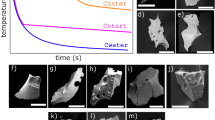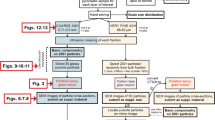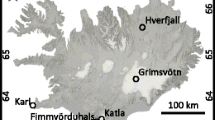Abstract
Morphometric analyses are based on multiparametric data sets that describe quantitatively the shapes of objects. The stochastic nature of fracture formation processes that break up magma during explosive eruptions yields mixtures of particles that have highly varied shapes. In volcanology, morphometric analysis is applied to these mixtures of particles with diverse shapes for two purposes: (1) to fingerprint tephra from individual eruptions and use the fingerprints to distinguish among tephra layers and determine their extents and (2) to reconstruct eruption processes, by linking particles formed by known fragmentation processes in experiments with particles from natural pyroclastic deposits. Here, we review the most commonly adopted statistical techniques for morphometric analysis of pyroclasts. We provide sets of objects with different shapes, along with their morphometric data, in order to demonstrate and illustrate the methods. They can be used not only for addressing the processes of fragmentation during explosive eruptions, but also for the characterization of other types of solid particles with complex morphologies.









Similar content being viewed by others
Data availability
All example data presented are provided in Online Resource 1.
Code availability
Not applicable.
References
Ahad NA, Yahaya SSS (2014) Sensitivity analysis of Welch’s t-test. AIP Conference Proceedings, In, pp 888–893
Alvarado GE, Mele D, Dellino P et al (2016) Are the ashes from the latest eruptions (2010–2016) at Turrialba volcano (Costa Rica) related to phreatic or phreatomagmatic events? J Volcanol Geotherm Res 327:407–415. https://doi.org/10.1016/j.jvolgeores.2016.09.003
Avery MR, Panter KS, Gorsevski PV et al (2017) Distinguishing styles of explosive eruptions at Erebus, Redoubt and Taupo volcanoes using multivariate analysis of ash morphometrics. J Volcanol Geotherm Res 332:1–13. https://doi.org/10.1016/j.jvolgeores.2017.01.010
Barrett PJ (1980) The shape of rock particles, a critical review. Sedimentology. https://doi.org/10.1111/j.1365-3091.1980.tb01179.x
Bender R, Lange S (2001) Adjusting for multiple testing—when and how? J Clin Epidemiol 54:343–349. https://doi.org/10.1016/S0895-4356(00)00314-0
Blanca MJ, Alarcón R, Arnau J et al (2017) Non-normal data: is ANOVA still a valid option? Psicothema 29:552–557. https://doi.org/10.7334/psicothema2016.383
Bonferroni CE (1936) Teoria statistica delle classi e calcolo delle probabilità. Pubbl del R Ist Super di Sci Econ e Commer di Firenze 8:3–62
Breiman L (2001) Random forests. Mach Learn
Büttner R, Dellino P, La Volpe L et al (2002) Thermohydraulic explosions in phreatomagmatic eruptions as evidenced by the comparison between pyroclasts and products from molten fuel coolant interaction experiments. J Geophys Res Solid Earth 107:2277. https://doi.org/10.1029/2001JB000511
Büttner R, Dellino P, Zimanowski B (1999) Identifying magma-water interaction from the surface features of ash particles. Nature; London 401:688–690. https://doi.org/10.1038/44364
Carey R, Soule SA, Manga M et al (2018) The largest deep-ocean silicic volcanic eruption of the past century. Sci Adv 4:e1701121. https://doi.org/10.1126/sciadv.1701121
Chávez GM, Castillo-Rivera F, Montenegro-Ríos JA et al (2020) Fourier shape analysis, FSA: freeware for quantitative study of particle morphology. J Volcanol Geotherm Res 404:107008. https://doi.org/10.1016/j.jvolgeores.2020.107008
Cioni R, D’Oriano C, Bertagnini A (2008) Fingerprinting ash deposits of small scale eruptions by their physical and textural features. J Volcanol Geotherm Res 177:277–287. https://doi.org/10.1016/j.jvolgeores.2008.06.003
Cioni R, Pistolesi M, Bertagnini A et al (2014) Insights into the dynamics and evolution of the 2010 Eyjafjallajökull summit eruption (Iceland) provided by volcanic ash textures. Earth Planet Sci Lett 394:111–123. https://doi.org/10.1016/j.epsl.2014.02.051
Coltelli M, Miraglia L, Scollo S (2008) Characterization of shape and terminal velocity of tephra particles erupted during the 2002 eruption of Etna volcano, Italy. Bull Volcanol 70:1103–1112. https://doi.org/10.1007/s00445-007-0192-8
Comida PP, Ross P-S, Dürig T, et al (2021) Standardized data acquisition for morphological and textural studies of juvenile pyroclasts in primary fragmentation studies; 2. Choice of size fraction and method optimization for particle cross-sections. Bull Volcanol submitted
Davis JC (2002) Statistics and data analysis in geology, 3rd edn. John Wiley & Sons, New York; Chichester; Brisbane
Dellino P, La Volpe L (1996) Image processing analysis in reconstructing fragmentation and transportation mechanisms of pyroclastic deposits. The case of Monte Pilato-Rocche Rosse eruptions, Lipari (Aeolian Islands, Italy). J Volcanol Geotherm Res 71:13–29. https://doi.org/10.1016/0377-0273(95)00062-3
Dellino P, La Volpe L, Isaia R, Orsi G (2001) Statistical analysis of textural data from complex pyroclastic sequences: implications for fragmentation processes of the Agnano-Monte Spina Tephra (4.1 ka), Phlegraean Fields, Southern Italy. Bull Volcanol 63:443–461. https://doi.org/10.1007/s004450100163
Dellino P, Liotino G (2002) The fractal and multifractal dimension of volcanic ash particles contour: a test study on the utility and volcanological relevance. J Volcanol Geotherm Res 113:1–18
Dioguardi F, Mele D, Dellino P, Dürig T (2017) The terminal velocity of volcanic particles with shape obtained from 3D X-ray microtomography. J Volcanol Geotherm Res 329. https://doi.org/10.1016/j.jvolgeores.2016.11.013
Donaldson TS (1968) Robustness of the F-test to errors of both kinds and the correlation between the numerator and denominator of the F-ratio. J Am Stat Assoc. https://doi.org/10.2307/2284037
Dürig T, Bowman M, White J et al (2018) PARTIcle Shape ANalyzer PARTISAN – an open source tool for multi-standard two-dimensional particle morphometry analysis. Ann Geophys 61:VO671. https://doi.org/10.4401/ag-7865
Dürig T, Mele D, Dellino P, Zimanowski B (2012a) Comparative analyses of glass fragments from brittle fracture experiments and volcanic ash particles. Bull Volcanol 74:691–704. https://doi.org/10.1007/s00445-011-0562-0
Dürig T, Schmidt LS, White JDL, Bowman MH (2020a) DendroScan: an open source tool to conduct comparative statistical tests and dendrogrammatic analyses on particle morphometry. Sci Rep 10:21682. https://doi.org/10.1038/s41598-020-78698-0
Dürig T, Sonder I, Zimanowski B et al (2012b) Generation of volcanic ash by basaltic volcanism. J Geophys Res Solid Earth 117:B01204. https://doi.org/10.1029/2011JB008628
Dürig T, White JDL, Murch AP et al (2020b) Deep-sea eruptions boosted by induced fuel–coolant explosions. Nat Geosci 13:498–503. https://doi.org/10.1038/s41561-020-0603-4
Dürig T, White JDL, Zimanowski B et al (2020c) Deep-sea fragmentation style of Havre revealed by dendrogrammatic analyses of particle morphometry. Bull Volcanol 82:67. https://doi.org/10.1007/s00445-020-01408-1
Dürig T, Zimanowski B (2012) “Breaking news” on the formation of volcanic ash: fracture dynamics in silicate glass. Earth Planet Sci Lett 335:1–8. https://doi.org/10.1016/j.epsl.2012.05.001
Ersoy O, Chinga G, Aydar E et al (2006) Texture discrimination of volcanic ashes from different fragmentation mechanisms: a case study, Mount Nemrut stratovolcano, eastern Turkey. Comput Geosci 32:936–946. https://doi.org/10.1016/j.cageo.2005.10.013
Games PA, Keselman HJ, Clinch JJ (1979) Tests for homogeneity of variance in factorial designs. Psychol Bull 86:978–984. https://doi.org/10.1037/0033-2909.86.5.978
Havlicek LL, Peterson NL (1974) Robustness of the t test: a guide for researchers on effect of violations of assumptions. Psychol Rep. https://doi.org/10.2466/pr0.1974.34.3c.1095
Heiken G (1974) Atlas of volcanic ash. Smithson Contrib to Earth Sci:1–101. https://doi.org/10.5479/si.00810274.12.1
Huberty CJ, Hussein MH (2003) Some problems in reporting use of discriminant analyses. J Exp Educ 71:177–192. https://doi.org/10.1080/00220970309602062
Iverson NA, Kyle PR, Dunbar NW et al (2014) Eruptive history and magmatic stability of Erebus volcano, Antarctica: insights from englacial tephra. Geochemistry, Geophys Geosystems 15:4180–4202. https://doi.org/10.1002/2014GC005435
Jordan SC, Dürig T, Cas RAF, Zimanowski B (2014) Processes controlling the shape of ash particles: results of statistical IPA. J Volcanol Geotherm Res 288:19–27. https://doi.org/10.1016/j.jvolgeores.2014.09.012
Kaiser HF (1958) The varimax criterion for analytic rotation in factor analysis. Psychometrika 23:187–200. https://doi.org/10.1007/BF02289233
Lawn B (1993) Fracture of brittle solids. Cambridge University Press
Leibrandt S, Le Pennec J-L (2015) Towards fast and routine analyses of volcanic ash morphometry for eruption surveillance applications. J Volcanol Geotherm Res 297:11–27. https://doi.org/10.1016/j.jvolgeores.2015.03.014
Levene H (1960) Robust tests for equality of variances. In: Olkin I, Ghurye SG, Hoeffding W et al (eds) Contributions to probability and statistics: essays in honor of Harold Hotelling. Stanford University Press, Menlo Park, CA, pp 278–292
Liu EJ, Cashman KV, Rust AC (2015) Optimising shape analysis to quantify volcanic ash morphology. GeoResJ 8:14–30. https://doi.org/10.1016/j.grj.2015.09.001
Loh WY (2011) Classification and regression trees. Wiley Interdiscip Rev Data Min Knowl Discov 1:14–23. https://doi.org/10.1002/widm.8
MacQueen J (1967) Some methods for classification and analysis of multivariate observations. Proceedings of the fifth Berkeley Symposium on Mathematical Statistics and Probability, In, pp 281–297
Maria A, Carey S (2002) Using fractal analysis to quantitatively characterize the shapes of volcanic particles. J Geophys Res Solid Earth 107:ECV 7-1–ECV 7-17. https://doi.org/10.1029/2001JB000822
Mele D, Costa A, Dellino P et al (2020) Total grain size distribution of components of fallout deposits and implications for magma fragmentation mechanisms: examples from Campi Flegrei caldera (Italy). Bull Volcanol 82:31. https://doi.org/10.1007/s00445-020-1368-8
Mele D, Dellino P, Sulpizio R, Braia G (2011) A systematic investigation on the aerodynamics of ash particles. J Volcanol Geotherm Res 203:1–11. https://doi.org/10.1016/j.jvolgeores.2011.04.004
Mueller SB, Houghton BF, Swanson DA et al (2018) Intricate episodic growth of a Hawaiian tephra deposit: case study of the 1959 Kīlauea Iki eruption. Bull Volcanol 80:73. https://doi.org/10.1007/s00445-018-1249-6
Mueller SB, Houghton BF, Swanson DA et al (2019) Total grain size distribution of an intense Hawaiian fountaining event: case study of the 1959 Kīlauea Iki eruption. Bull Volcanol 81:43. https://doi.org/10.1007/s00445-019-1304-y
Murtagh RM, White JDL (2013) Pyroclast characteristics of a subaqueous to emergent Surtseyan eruption, Black Point volcano, California. J Volcanol Geotherm Res 267:75–91. https://doi.org/10.1016/j.jvolgeores.2013.08.015
Németh K, Cronin SJ (2011) Drivers of explosivity and elevated hazard in basaltic fissure eruptions: the 1913 eruption of Ambrym Volcano, Vanuatu (SW-Pacific). J Volcanol Geotherm Res 201:194–209
Németh K, Kósik S (2020) The role of hydrovolcanism in the formation of the Cenozoic monogenetic volcanic fields of Zealandia. New Zeal J Geol Geophys:1–26. https://doi.org/10.1080/00288306.2020.1770304
Nurfiani D, de Maisonneuve CB (2018) Furthering the investigation of eruption styles through quantitative shape analyses of volcanic ash particles. J Volcanol Geotherm Res 354:102–114
Pardo N, Avellaneda JD, Rausch J et al (2020) Decrypting silicic magma/plug fragmentation at Azufral crater lake, Northern Andes: insights from fine to extremely fine ash morpho-chemistry. Bull Volcanol 82:79. https://doi.org/10.1007/s00445-020-01418-z
Perneger TV (1998) What’s wrong with Bonferroni adjustments. BMJ 316:1236–1238. https://doi.org/10.1136/bmj.316.7139.1236
Rasch D, Guiard V (2004) The robustness of parametric statistical methods. Psychol Sci 46:175–208
Rausch J, Grobéty B, Vonlanthen P (2015) Eifel maars: quantitative shape characterization of juvenile ash particles (Eifel Volcanic Field, Germany). J Volcanol Geotherm Res 291:86–100. https://doi.org/10.1016/j.jvolgeores.2014.11.008
Richter DH, Eaton JP, Murata KJ et al (1970) Chronological narrative of the 1959-60 eruption of Kilauea Volcano. Hawaii. US Geol Surv Prof Pap 537-E(E):1–73
Ross P-S, Dürig T, Comida PP, et al (2021) Standardized data acquisition for morphological and textural studies of juvenile pyroclasts in primary fragmentation studies; 1. Overview and workflow. Bull Volcanol submitted:
Rustam Z, Hartini S, Pratama RY, et al (2020) Analysis of architecture combining Convolutional neural network (CNN) and kernel K-means clustering for lung cancer diagnosis. Int J Adv Sci Eng Inf Technol. 10.18517/ijaseit.10.3.12113
Satorra A, Bentler PM (1994) Corrections to test statistics and standard errors in covariance structure analysis. In: Eye A, Clogg CC (eds) Latent variables analysis: applications for developmental research. Sage Publications Inc., Thousand Oaks, CA
Scasso RA, Carey S (2005) Morphology and formation of glassy volcanic ash from the August 12-15, 1991 eruption of Hudson volcano, Chile. Lat Am J Sedimentol Basin Anal 12:3–21
Schipper CI, Sonder I, Schmid A et al (2013) Vapour dynamics during magma–water interaction experiments: hydromagmatic origins of submarine volcaniclastic particles (limu o Pele). Geophys J Int 192:1109–1115. https://doi.org/10.1093/gji/ggs099
Schmith J, Höskuldsson Á, Holm PM (2017) Grain shape of basaltic ash populations: implications for fragmentation. Bull Volcanol 79:14. https://doi.org/10.1007/s00445-016-1093-5
Shoji D, Noguchi R, Otsuki S, Hino H (2018) Classification of volcanic ash particles using a convolutional neural network and probability. Sci Rep. https://doi.org/10.1038/s41598-018-26200-2
Student (1908) The probable error of a mean. Biometrika 6:1–25. https://doi.org/10.2307/2331554
Suzuki K, Fujiwara H, Ohta T (2015) The evaluation of macroscopic and microscopic textures of sand grains using elliptic Fourier and principal component analysis: implications for the discrimination of sedimentary environments. Sedimentology 62:1184–1197. https://doi.org/10.1111/sed.12183
Taddeucci J, Cimarelli C, Alatorre-Ibargüengoitia MA et al (2021) Fracturing and healing of basaltic magmas during explosive volcanic eruptions. Nat Geosci 14:248–254. https://doi.org/10.1038/s41561-021-00708-1
Taddeucci J, Pompilio M, Scarlato P (2002) Monitoring the explosive activity of the July-August 2001 eruption of Mt. Etna (Italy) by ash characterization. Geophys Res Lett 29:71–74. https://doi.org/10.1029/2001GL014372
Tang JL, Wang D, Zhang ZG et al (2017) Weed identification based on K-means feature learning combined with convolutional neural network. Comput Electron Agric 135:63–70. https://doi.org/10.1016/j.compag.2017.01.001
Tukey JW (1949) Comparing individual means in the analysis of variance. Biometrics 5:99–114
Tunwal M, Mulchrone KF, Meere PA (2020) A new approach to particle shape quantification using the curvature plot. Powder Technol 374:377–388. https://doi.org/10.1016/j.powtec.2020.07.045
Tunwal M, Mulchrone KF, Meere PA (2018) Quantitative characterization of grain shape: implications for textural maturity analysis and discrimination between depositional environments. Sedimentology 65:1761–1776. https://doi.org/10.1111/sed.12445
Verolino A, White JDL, Dürig T, Cappuccio F (2019) Black Point – pyroclasts of a Surtseyan eruption show no change during edifice growth to the surface from 100 m water depth. J Volcanol Geotherm Res 384:85–102. https://doi.org/10.1016/j.jvolgeores.2019.07.013
Vonlanthen P, Rausch J, Ketcham RA et al (2015) High-resolution 3D analyses of the shape and internal constituents of small volcanic ash particles: the contribution of SEM micro-computed tomography (SEM micro-CT). J Volcanol Geotherm Res 293:1–12. https://doi.org/10.1016/j.jvolgeores.2014.11.016
Walker E, Nowacki AS (2011) Understanding equivalence and noninferiority testing. J Gen Intern Med 26:192–196. https://doi.org/10.1007/s11606-010-1513-8
Welch BL (1947) The generalization of ‘Student’s’ problem when several different population variances are involved. Biometrika 34:28–35. https://doi.org/10.2307/2332510
Wellek S (2010) Testing statistical hypotheses of equivalence and noninferiority. Chapman and Hall/CRC
White JDL, Valentine GA (2016) Magmatic versus phreatomagmatic fragmentation: absence of evidence is not evidence of absence. Geosphere 12:1478–1488. https://doi.org/10.1130/GES01337.1
Wohletz KH (1983) Mechanisms of hydrovolcanic pyroclast formation: grain-size, scanning electron microscopy, and experimental studies. J Volcanol Geotherm Res 17:31–63. https://doi.org/10.1016/0377-0273(83)90061-6
Acknowledgements
Louise Steffensen Schmidt is thanked for reading an earlier version of the manuscript. We thank Adrian Hornby and an anonymous reviewer, as well as associate editor Benjamin Andrews, for their constructive comments that helped in improving the manuscript. Furthermore, we gratefully acknowledge Sebastian Mueller, Bruce Houghton and Wendy Cockshell for providing the Kīlauea Iki 1959 samples. TD is supported by the Icelandic Research Fund (Rannís), grant Nr. 206527-051.
Funding
TD was supported by the IRF (Rannís) Postdoctoral project grant 206527-051.
Author information
Authors and Affiliations
Corresponding author
Ethics declarations
Conflict of interest
The authors declare no competing interests.
Additional information
Editorial responsibility: B.J. Andrews
This paper constitutes part of a topical collection: What pyroclasts can tell us.
Supplementary information
Online Resource 1
(.rar) Silhouettes of “artificial” objects and data sets with morphometric parameters used for demonstration. (RAR 3629 kb)
Online Resource 2
(.rar) Silhouettes of “natural” ash silhouettes from the 1959 Kīlauea Iki and the 2012 Havre eruption, as well as data sets with their morphometric parameters. (RAR 161 kb)
Online Resource 3
(.xlsx) Table with principal components for all demonstration silhouettes, before and after “varimax” rotation. (XLSX 12 kb)
Online Resource 4
(.xlsx) Tables showing the results from k-means procedure, applied to data sets “a”, “d” and “e”, using 10 iterations with k = 3 and k = 2. (XLSX 12 kb)
Rights and permissions
About this article
Cite this article
Dürig, T., Ross, PS., Dellino, P. et al. A review of statistical tools for morphometric analysis of juvenile pyroclasts. Bull Volcanol 83, 79 (2021). https://doi.org/10.1007/s00445-021-01500-0
Received:
Accepted:
Published:
DOI: https://doi.org/10.1007/s00445-021-01500-0




